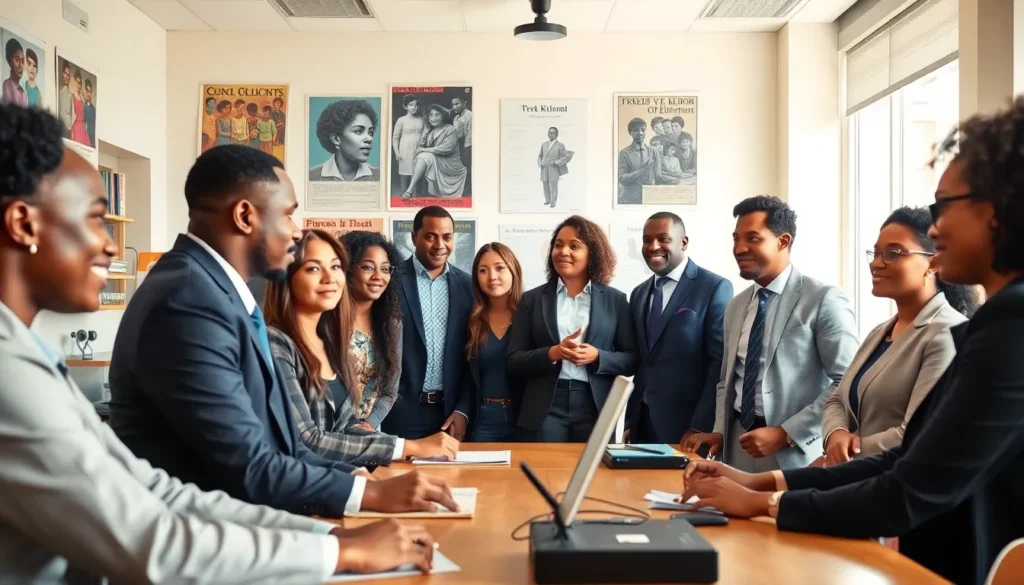Table of Contents
ToggleEver wondered how a case from the 1950s can touch your life today? Well, buckle up. The ripple effects of Brown v. Board of Education are still shaping our educational landscape and social dynamics. It’s like that initial stone thrown into a pond, its waves reach far and wide, impacting everything from school policies to the very fabric of our society. So, let’s jump into this fascinating legal saga that transformed a nation.
Historical Context Of Brown V. Board Of Education

To understand the monumental significance of Brown v. Board of Education, one must first appreciate the climate of America in the mid-20th century. The country was still deeply entrenched in the Jim Crow laws, which enforced racial segregation. These laws established separate but supposed equal facilities for whites and African Americans, a doctrine upheld by the Supreme Court largely due to the precedent set by Plessy v. Ferguson in 1896.
By the time the 1950s rolled around, African American families, educators, and civil rights activists had grown increasingly frustrated with the pervasive inequality. Parents such as Oliver Brown, who challenged the Topeka, Kansas, school board’s policy, became the face of this battle. They sought not just a change in policy but also a shift in public consciousness that proclaimed segregation was fundamentally flawed. This backdrop sets the stage for the landmark decision that would challenge the very essence of segregation and redefine public education.
The Court’s Ruling and Its Immediate Impact
In May 1954, the Supreme Court handed down its unanimous ruling in Brown v. Board of Education, stating that “separate educational facilities are inherently unequal.” This ruling was a watershed moment in American history. It invalidated the legal footing of segregation, declaring it unconstitutional.
The immediate aftermath of this ruling was a mixed bag. Some school districts promptly began integrating their schools, but many others resisted vehemently. The decision prompted a swirl of social turmoil and unrest, especially in the South. Notably, in Little Rock, Arkansas, a significant showdown occurred in 1957 when a group of nine African American students, now known as the Little Rock Nine, faced hostile crowds and defiance from state authorities, all while attempting to enter Central High School. The federal government had to step in, illustrating that the journey toward equality was far from over.
Long-Term Effects On Education Systems
The long-term effects of Brown v. Board of Education on the American education system have been profound. It laid the groundwork for the Civil Rights Movement and prompted legislative changes like the Elementary and Secondary Education Act of 1965. This act aimed to provide federal funding to schools seeking to improve education for students from low-income families, which disproportionately included African American youth.
Even though these advancements, the promise of equal education remains elusive. The fight against systemic inequality in education continues, manifesting in various forms, such as the discussion surrounding school funding and resource allocation. Many schools in predominantly minority neighborhoods still struggle with overcrowding and insufficient funding, highlighting the disparities that linger decades after the ruling.
Cultural and Social Implications
Beyond just educational impact, Brown v. Board of Education served as a catalyst for cultural and social change. It gave rise to a greater awareness of racial inequality, influencing a wave of activism across the nation. Movies, music, literature, and art began to reflect the rising sentiments against injustice.
Also, the case illuminated the need for societal introspection. It spurred crucial dialogue surrounding issues of race, injustice, and American identity. Events such as the Montgomery Bus Boycott and the Freedom Rides took inspiration from the courage displayed during this legal battle, showcasing the broader implications of the ruling in fostering a more just society.
Ongoing Challenges and Current Relevance
Even in today’s society, the teachings of Brown v. Board of Education resonate loudly. While the legal system made great strides, challenges persist. School re-segregation, often a result of socioeconomic dynamics, reflects ongoing battles. Many educational institutions find themselves grappling with the consequences of an uneven playing field.
Also, contemporary debates surrounding standardized testing, school vouchers, and funding disparities reveal how the fight for equality in education is still very much alive. As educators and policymakers navigate these issues, the principles from Brown continue to be a beacon of hope for advocates of equal education.
Brown V. Board Of Education In Modern Legal Context
In the modern legal landscape, Brown v. Board of Education remains a cornerstone of civil rights jurisprudence. It set a legal precedent that courts continue to reference in cases concerning discrimination and educational equality. The ruling has prompted subsequent decisions that defend against various forms of discrimination, reinforcing the importance of equal treatment under the law.
But, it’s essential to acknowledge both the triumphs and the hurdles that remain. While the Supreme Court continues to interpret and rule on matters of educational rights, the underlying issues of equity and justice require constant vigilance and activism to ensure that progress remains steadfast.




